Unit 3 Manners(teaching plan)
Unit 3 Manners高一新世纪版本最新教案原创课件(共17张)
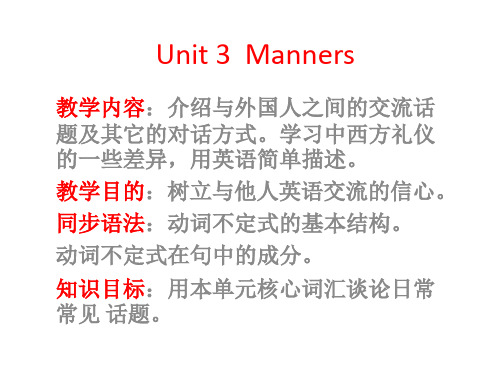
C write a short passage about how you learn
English ,using the infinitive ,if possible.
• To learn English well, I try to spend more time on it every day .In the morning I listen to the tape and practise reading to improve my pronunciation. I like to read English story books ,which helps me a lot in speaking and writing .
自己根据学习情况组织语言。
the street. • 4)picking your nose in public. • 5)staring at sb in public.
A . Study the picture and answer the following questions.
Tell a story according to the picture .Try to be creative.
B. Text Moving on to read
Question : Which sentence explains the meaning “tongue-tied”?
• But no words came into your head.
• Tongue-tied 应感到难堪而张目 结舌。
•
•
11、只有让学生不把全部时间都用在学习上,而留下许多自由支配的时间,他才能顺利地学习……(这)是教育过程的逻辑。21.8.3100:55:0900:55Aug-2131-Aug-21
七年级英语下unit3课件Teaching Plan For Unit3
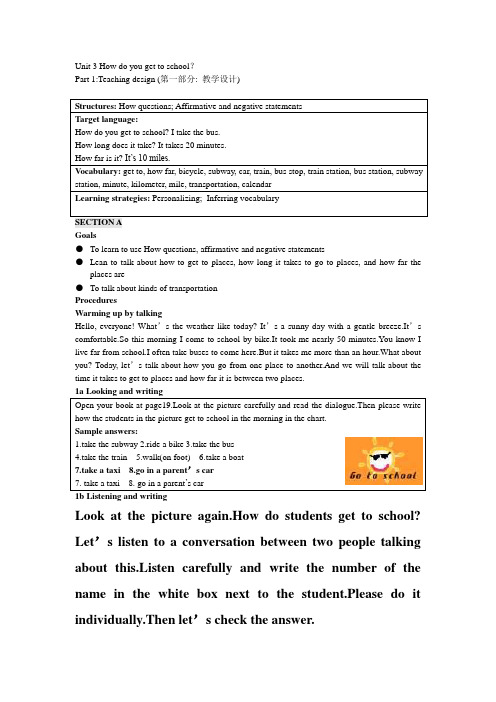
Unit 3 How do you get to school?Part 1:Teaching design (第一部分: 教学设计)Structures: How questions; Affirmative and negative statementsTarget language:How do you get to school? I take the bus.How long does it take? It takes 20 minutes.How far is it? It’s 10 miles.Vocabulary: get to, how far, bicycle, subway, car, train, bus stop, train station, bus station, subway station, minute, kilometer, mile, transportation, calendarLearning strategies: Personalizing; I nferring vocabularySECTION AGoals●To learn to use How questions, affirmative and negative statements●Lean to talk about how to get to places, how long it takes to go to places, and how far theplaces are●To talk about kinds of transportationProceduresWarming up by talkingHello, everyone! What’s the weather like today? It’s a sunny day with a gentle breeze.It’s comfortable.So this morning I come to school by bike.It took me nearly 50 minutes.You know I live far from school.I often take buses to come here.But it takes me more than an hour.What about you? Today, let’s talk about how you go from one place to another.And we will talk about the time it takes to get to places and how far it is between two places.1a Looking and writingOpen your book at page19.Look at the picture carefully and read the dialogue.Then please write how the students in the picture get to school in the morning in the chart.Sample answers:1.take the subway2.ride a bike3.take the bus4.take the train5.walk(on foot)6.take a boat7.take a taxi 8.go in a parent’s car7. take a taxi 8. go in a parent’s car1b Listening and writingLook at the picture again.How do students get to school? Let’s listen to a conversation between two people talking about this.Listen carefully and write the number of the name in the white box next to the student.Please do it individually.Then let’s check the answer.Answers:1.Bob takes the train.2.Mary takes the subway.3.John takes the bus.4.Paul walks.5.Yang Lan walks.TapescriptA: How do Bob and Mary get to school?B: Bob takes the train and Mary takes the subway.A: How does John get to school?B: He takes the bus.A: How do Paul and Yang Lan get to school?B: They walk.Look, there they are waling now!B: They walk. Look, there they are waling now!Now read the tapescript, shadow the how questions and underling the expressions.1c Doing pairworkPlease read the dialogue on page 19 in the box.And make your own conversations about how the people in the picture get to school with their partner.Then I’ll ask some pairs to say their dialogue. Sample dialogueA: How does Bob get to school?B: He takes the train.A: Does John take the train to school, too?B: No.He takes the bus.A: What about Mary and Paul?B: Paul walks, and Mary takes the subway.A: And Yang Lan walks, does she?B: Yes, she does.B: Yes, she does.2a Listening and repeatingListen to these numbers and repeat.Please pay attention to the pronunciation.Tapescript32, 40, 50, 60, 70, 80, 90, 1002b Writing the numbersforty-six 46 thirty-three 33 seventy-two 72one hundred and five 105 fifty-eight 58 ninety-nine 99sixty-one 61 eighty-four 842c Listening and checkingNow please look at the five transportation pictures.And we’ll listen to two conversations.The people are talking about how students get to school and how long it takes.Listen carefully and put a checkmark to show the kinds of transportation they talk about.Check your answer.40 minutes 35minutes25minutes10 minutesListen carefully again and match the time with the kinds oftransportation.Let’s check the answers.TapescriptConversation 1Boy: How do you get to school?Girl: I take the train.Boy: How long does it take?Girl: Oh, around forty minutes.Howabout you?Boy: I take the subway.Girl: How long does that take?Oh, around thirty-five minutes.Conversation 2Girl: How do you get to school, Tom?Tom: I ride my bike.Girl: How long does it take?Tom: It takes around twenty-five minutes.Tom: How do you get to school?Girl: I walk.Tom: And how long does that take?Girl: It only takes ten minutes.Look at the sentences on the board.“They take the train.It takes about forty minutes.”“Take the train”means to ride the train.And we also use “take”to talk about a length of time.For example, it takes me 20minutes to get to school.So we use the same word, take, in two different ways.Now read the tapescript, shadow the how questions and underling the expressions.2d Doing pairworkNow please make your own conversations about how you get to school and how long it takes.Read the example dialogue first then make yours with your partner.Example:A: How do you get to school?B: well, I usually walk but sometimes I take the bus.A: How long does it take?B: It takes about 25 minutes to walk and 10 minutes by bus.What about you?A: I get to school by bike, sometimes I take my father’s car.B: Oh, how long does it take?A: It takes around 40 minutes by bike and 15 minutes by car.3a Reading and writingSo far you have learned to talk about how you get to school and how long it takes.The passage you will learn in this part tells us something about Li Lei.Please read the questions about Li Lei in the speech bubbles.Then read the passage and write the answers to the questions on the line.You should complete the activity individually.OK, now let’s check the answers.1How does he 2 How long does 3 How far is it fromget to school? it take? his home to school?By bike and It usually takes About 10 kilometers.by bus. about 35 minutes.by bus. about 35 minutes.Now read the passage following the tape sentence by sentence.Please pay attention to the pronunciation and intonation of the native readers and try to imitate them.Then draw lines under the useful phrases and structures.Lin Fei’s home/ is about 10 kilometers /from school.He gets up /at six o’clock/ every day, showers, and has a quick breakfast.Then/ he leaves for school/ at around six-thirty.First, he rides his bicycle/ to the bus station.That takes about ten minutes.Then/ the early bus/ takes him to school.The bus ride/ usually/ takes about 25 minutes.Lin Fei’s home/ is about 10 kilometers /from school. He gets up /at six o’clock/ every day, showers, and has a quick breakfast. Then/ he leaves for school/ at around six-thirty. First, he rides his bicycle/ to the bus station. That takes about ten minutes. Then/ the early bus/ takes him to school. The bus ride/ usually/ takes about 25 minutes.Ok, we have got to know something about Li Lei.What about you? How far are your homes from school? What time do you get up? How do you get to school? Let’s ask some students to say something about you.3b Doing pairworkLook at the pictures on page 21.Can you name each form of transportation? They are easy to you.Read the time and distance that goes with each form of transportation.Pay attention to “mile”, which is a common measure of distance in some western countries.(1 mile=1.6 kilometers).Read the example dialogue in the box.Now make your own conversations using the information in the picture with your partner.A: How do you get to school?B: I take the train.A: How far is it from your home to school?B: It’s eight miles.A: How long does it take you to get from home toSchool ?B: It takes 35 minutes.A: How do you get to school?B: I walk.A: How far is it from your home to school?B: It’s two miles.A: How long does it take you to get from home to school ?B: It takes 40 minutes.A: How do you get to school?B: I take the bus.A: How far is it from your home to school?B: It’s four miles.A: How long does it take you to get from home to school?B: It takes 15 minutes.OK.Stop here please.Let’s ask some pairs to say their dialogues.4 Talking and writingHow How long How far Well done everyone!Now let’s play agame: Info Gap Race!This time you work ingroups of three.Youdecide which one is A,which one is B andwhich one is C.Pleaseread theinstruction.You askeach other questionsto learn informationfor your chart, andthen write the answerson the chart in yourbook.Don’t look atothers’pagesplease.The first groupto fill in all the blanksis the champion.Who1.Maria bus twenty minutes five miles2.John bike ten minutes six miles3.Liu Pei subway fifteen minutes eight miles Sample dialogue:C:How does Maria get to school?A: She takes the bus.How long does it take Maria to get to school?B: It takes her twenty minutes.How far is it from her home to school?C:It’s five miles.Closing down by asking and answering(using the useful information learned in this part)*How do you get to school?*I usually walk, but sometimes I take the bus.*How long does it to take you to get from your home to school?*It takes 25 minutes.*How far is it from your home to school?*It’s around 4miles. A bus station Section BGoals●To learn to use: bus stop, train station, subway station●To learn to talk about how to get to places further.ProceduresWarming up by asking some individuals questionsHow does Li Lei get to school? First, he rides his bicycle to the bus station.Then he takes the early bus to school.Do you know the bus station? It’s a place where trains stop here.Today we’ll study some other “stations”.1a Looking and matchingLook at the four phrases on the top of page 22 and read them loudly.Then match the words with the pictures.Answers: 1.b bus stop 2.a train station 3.c bus station 4.d subway stationAnswers: 1. b bus stop 2. a train station 3. c bus station 4. d subway station1b Doing pairworkRead the dialogue in the box first.Then suppose you use two kinds of transportation to get to school.Now make your own dialogues to tell your partner how you get to school, using the phrases in 1a.Sample dialogue:A: How do you get to school?B: Well, I ride my bike to the subway station.Then I take the subway.Whatabout you?A: First, I walk to the bus stop.Then I take the bus to school.A: How does your father get to his school?B: Well, he walks for ten minutes to Bus No.11.He takes the bus and gets off at Da Yingpan.Then he walks again for five minutes to his classroom.B: Well, he walks for ten minutes to Bus No. 11. He takes the bus and gets off at Da Yingpan. Then he walks again for five minutes to his classroom.2a Listening and checkingOK, now.Let’s listen to the conversation between Tina and Thomas.What does Thomas want to know about Nina? Here is a list of information that Thomas wants to know.I’ll ask some students to read lines to the class.Then listen carefully and put a checkmark in front of each thing that Thomas wants to know.Thomas wants to know…√where Nina lives.how far from school she lives.how long it takes Nina to get to school.√how she gets to school.what she thinks of the transportation.2b Listening and checking1.Look at the pictures on page 22 with a blank line in front of each.They show the ways ofhow to get to school.Which one is Nina’s? Listen carefully and put a checkmark next to the picture that shows how Nina gets to school.2.—to ride a bike to the subway—to take the subway tothe bus—to walk from the bus stop to the school2.√to walk to the bus—to take the bus to the subway—totake another bus after the subway—to walk from the busstop to the school.TypescriptThomas: Where do you live, Nina?Nina: New Street.Thomas: So, how do you get to school?Nina: Well, first I walk to the bus stop.Thomas: Uh-huh.Nina: I take a bus to the subway station.Then I take the subway.Thomas: Yeah…Nina: Next I take a bus to the bus stop on 26thStreet.Finally I walk.You may turn to the tapescript to read it, underlining theexpressions and shadowing the how questions.2c Doing groupworkNow make your conversations about how Nina gets to school in groups of four.You can use the pictures in activity 2b.Pay more attention to the sentence starters: She…; Next, she…; Then, she…in the box and use them in your conversation.Sample dialogue:A: How does Nina get to school?B: She walks to the bus stop.C: Next, she takes a bus to the subway station.D: Then she takes another bus to the bus stop on 26th street after the subway.A: Finally she walks to school.Now let’s ask some of you to say your descriptions to the class.3a Reading and writingNow you can say something about how you get to school.Do you want to know how students around the world get to school? Read the article on page 23, and then decide if the statements are true or false in your exercise book.Check the answers:T 1.In North America, not all students take the bus to school.T 2.Other parts of the world are different from the United States.F 3.In Japan, the three most popular ways of getting to school are bus, train and bike.(Students take trains, or walk, or ride bikes)F 4.In China, bikes and buses are the most popular means of transportation.(It depends on where you are)T 5.Students in Hongshanhu and Kaishandao have to take a boat to get to school.Read the article once again, this time, to slash/ the sentences, underline the useful expressions in it and shadow the connectives.After school, you are going to write them down in your notebook. How do students around the world get to school?In North America, most students/ go to school/ on the school bus.Some students/ also walk/ or ride bikes to school.In other parts of the world, things are different.In Japan, most students/ take trains to school, although others also walk/ or ride their bikes.In China, it depends on /where you are.In big cities, students usually ride bikes to school/ or take buses.And in places/ where there are rivers and lakes, like Hongshanhu and Kaishandao, students usually go to school/ by boat.That must be a lot more fun/than taking a bus!In North America, most students/ go to school/ on the school bus. Somestudents/ also walk/ or ride bikes to school. In other parts of the world,things are different. In Japan, most students/ take trains to school, although others also walk/ or ride their bikes. In China, it depends on /where you are. In big cities, students usually ride bikes to school/ or take buses. And in places/ where there are rivers and lakes, like Hongshanhu and Kaishandao, students usually go to school/ by boat. That must be a lot more fun/ than taking a bus! 3b Reading and writingLook at the chart.Then read the article and fill in the blanks.You can find theanswers in the chart.Please complete the activity individually.Check the answers:How do the students get to Garden High School?At Garden High School, most students ride their bikes to school.Many students walk.Some students drive.Other students take the bus.A small number of students take the subway.At Garden High School, most students ride their bikes to school. Many students walk. Some students drive. Other students take the bus. A small number of students take the subway.3c WritingJust now we filled in an article about how students get to Garden High School.What about you? How do students in our class get to school? Let’s make a survey and list your ideas on the board.You can use the words and numbers to write a passage about how students in our class get to school.Sample passage:In my class, most students ride their bikes to school.Many students go to school on foot.Some students live far from school, so they go to school by bus.A few students take their parents' car to school.At Taiyuan Wuzhong, most students live at school.They just walk to their classroom.So they don’t ride their bikes to school.Many students play on the playground in the early morning.Some students play football.Some read aloud their English texts.But at the same time, other students in other schools have to take the bus, ride the bike, to hurry to their schools.4 Making a surveyNow turn to page 82, please.Look at the chart.Read the heading and the phrases listed below.Please complete the chart in ten minutes.You can go around the class and ask questions to find out the answers.Look at the dialogue in the box next to the chart.You can ask questions likeThe first student to fill all the blanks wins.Let’Namess see who the champion is.Find someone who…lives 10 miles away from school.walks to school.takes a bus to school.takes more than an hour to get to school.ride s a bike to school.takes the subway to school.takes less than ten minutes to get to school.Closing up by discussing the main points of this partDo you remember Nina? How does she get to school? How do students around the world get to school? Please tell me in your own words.And I will also ask some of you to say something about themselves.Who will be the first to have a try?SELF CHECKGoals●To revise the vocabulary introduced in the unit●To practice writing skillProcedures1 Filling the blanks and making sentencesLook at part 1 on page 24.Fill in the blanks with the words given to you.Change the form of the word if necessary.Check the answers:1.How do you get to school in the morning?2.What do you think of the transportation in your town?3.When it rains I take a taxi.4.How far do you live from the bus station?5.I like to ride my bike on the weekend.1.Now make your own sentences with the words.I’ll ask some students to write the answers onthe board.And then we shall correct their mistakes together if they get any.2.When will you get to Beijing?3.I cannot think of any good methods to learn English.4.I take a plane to go to my school in Shanghai.5.My teacher lives close to the school.6.I never ride a bike in life.But I like riding horses sometimes.7.I never ride a bike in life. But I like riding horses sometimes.SundayOn page 18 is a schedules planned for touriststo your city.Finish the schedule.SaturdayMorning: take a bus around the city, go Morning: go to visit Mt.WutaiLet’s sing a son g in English.Three Blind MiceThree blind mice, see how they run!They all ran after the farmer's wife,Who cut off their tails with a carving knife,Did you ever see such a thing in your life,As three blind mice?Part 2: Teaching resources(第二部分:教学资源)I.Background reading1.Traffic in EnglandWhen you are in England, you must be very careful in the streets because the traffic drives on the left.Before you cross a street, you must look to the right first and then the left.If the traffic lights are red, the traffic must stop.Then people on foot can cross the road carefully.If the traffic lights are green, the traffic can go.People on foot mustn't cross.In the morning and in the evening when people go to or come from work, the streets are very busy.Traffic is the most dangerous then.When you go by bus in England, you have to be careful, too.Always remember the traffic moves on the left.So you must be careful.Have a look first, or you will go wrong.In many English cities, there are big buses with two floors.You can sit on the second floor.From there you can see the city very well.It's very interesting!III.Word studies (词语学习)1.takev.1.抓住拾起 get hold of something or someone; pick something up: Please take my hand.请拉住我的手。
unit3 manners

Summing up
Different countries have different cultures. We should pay attention to these differences during the intercultural communication.
Now, let’s appreciate a video
习惯
Warm-up
Look at the some Pictures and complete the sentences with the following structure:
It is good/bad manners to…
It is
good
manners to .
help the older people
impolite to ask a foreigner his/her age?
A: 他可能不知道那个习惯。他不太了解外国人和他们的文化。
He probably doesn’t know that custom. He doesn’t know much about foreigners and their culture.
Inappropriate: age; marriage; salary; religious beliefs
Appropriate: weather; interests/hobby
“Manners make the man.”
Dialogue-Listening
A: Did you hearXiao Wang? He just asked that foreign lady her age . B:You’re kidding ! Doesn’t he know it is impoliteto ask a foreigner his or her age . A: He probably doesn’t know that custom. He doesn’t know much about foreigners and their culture . B: Yeah, he’s a little ignorant of the outside world. But he has a goodunderstanding of Chinese customs and proper behavior here at home. By the way, I wonder why foreigners are so sensitive about revealing their age . A: I’m not sure. I think they like to give the impression that they are young. B: How strange! I would like to appear older so that I can gain more respect .
Unit 3 Whatever Happened to Manners Teaching plan 综合教程一
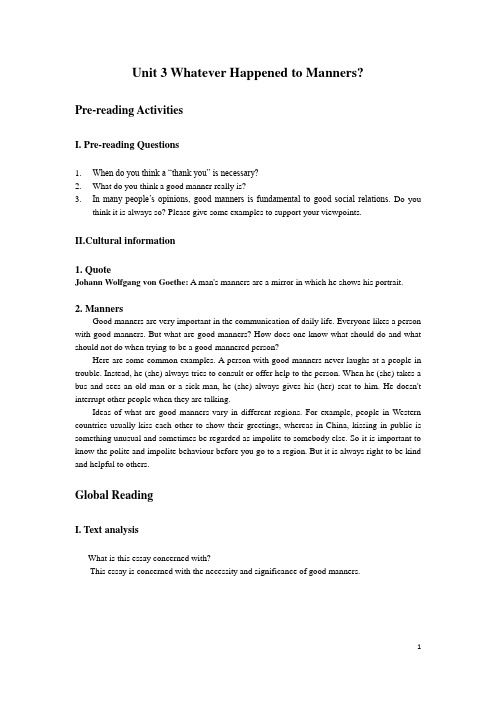
Unit 3 Whatever Happened to Manners?Pre-reading ActivitiesI. Pre-reading Questions1.When do you think a “thank you” is necessary?2.What do you think a good manner really is?3.In many people’s opinions, good manners is fundamental to good social relations. Do youthink it is always so? Please give some examples to support your viewpoints.II.Cultural information1. QuoteJohann Wolfgang von Goethe:A man's manners are a mirror in which he shows his portrait.2. MannersGood manners are very important in the communication of daily life. Everyone likes a person with good manners. But what are good manners? How does one know what should do and what should not do when trying to be a good-mannered person?Here are some common examples. A person with good manners never laughs at a people in trouble. Instead, he (she) always tries to consult or offer help to the person. When he (she) takes a bus and sees an old man or a sick man, he (she) always gives his (her) seat to him. He doesn't interrupt other people when they are talking.Ideas of what are good manners vary in different regions. For example, people in Western countries usually kiss each other to show their greetings, whereas in China, kissing in public is something unusual and sometimes be regarded as impolite to somebody else. So it is important to know the polite and impolite behaviour before you go to a region. But it is always right to be kind and helpful to others.Global ReadingI. Text analysisWhat is this essay concerned with?This essay is concerned with the necessity and significance of good manners.II. Structural analysis1. How is the essay organized?Detailed ReadingText IParagraph 1Questions:1. Which sentences in the first paragraph imply that in a general sense, people now are less gentle, less friendly or less polite than people in the past?2. What examples does the writer give to show that many people in New York City are notfriendly or polite with one another?Paragraphs 2-4Questions:1. According to the writer, how do good manners build up your image? (Paragraph 4)2. How do you understand the sentence “we can’t be truly stylish without good manners”? (Paragraph 2)Paragraphs 5-10Questions:1. What good manners does the writer suggest that we should display?2. Do you agree with the writer that good manners with our families count the most? Justify your reply. (Paragraph 9)Paragraph 11Questions:1. Do you believe that good manners are infectious? Exemplify your answer.2. Is it possible for everyone to show good manners?Further EnhancementText IILead-in questions1. Share one of your stories about your most respected teacher with the class and tell the reasons for your admiration for him/her.2. In addition to transmitting knowledge, what do your think are the teacher’s other responsibilities?Notes1. sound-bites (Paragraph 1): short sentences or phrases that are easy to remember, often included in a speech made by a politician and repeated in newspapers and on television and radio2. for me to push from my consciousness thoughts about the danger (Paragraph 1): for me to stop thinking about the danger3. adolescents (Paragraph 2): A very young child is a baby or more formally an infant. A child who has just learned to walk is a toddler. People aged 13 to 19 are teenagers and a younger teenager may also be called an adolescent. An adult is a fully-grown person over an age stated by law, usually 18 or 21.4. profanity (Paragraph 2): "Profanity" shows a lack of respect for a god or a religion, especially through language. Here it refers to offensive language used by some students.5. peers (Paragraph 2): persons of the same age, class, position, etc., as oneselfe.g.The opinions of his peers are more important to him than his parentsPeer pressure is a great influence on the way people behave.6. ethical bystanders (Paragraph 3): people who watch sth. that is happening, but do not want to say whether they think it is right or wrong in human behaviour7. the innate worth of every human being (Paragraph 3): the value that every human being is born with8. … I should be busy with more important things rather than finding fault with … (Paragraph 4): Note the use of the -ing form after rather than, which joins two -ing forms.e.g. He likes starting early rather than staying late.However, when two infinitive structures are joined by rather than, the second infinitive is usually without "to".e.g.Rather than wait any more, I decided to go home by taxi.9. prerogatives (Paragraph 5): rights or privileges exclusive to an individual or classe.g. Our company exercises our prerogative to employ people according to their ability, but notaccording to the number of certificates they have.10. notwithstanding (Paragraph 5): in spite of the fact or thing mentioned. It is a preposition usedeither before or after its object. It is usually used in formal language.e.g.They are determined to go ahead with the plan, widespread public oppositionnotwithstanding.The plane landed on time, notwithstanding the terrible weather conditions.Questions for discussion1. What worries does the author express at the beginning of the article?2. What evidence does the author provide to prove that basic human values are declining?3. Do parents and school educators agree with each other concerning the responsibility for the moral education of the children? If not, how do they disagree?4. Apart from lack of responsibility, do you think that the author is also criticizing some parents’attitude towards the teacher? Cite an example to prove this.5. What values does the author think should be taught to students?6. What is the author’s conception of a successful educator?7. Wh at are your ideas of an educator’s moral responsibility?Key to Questions for discussion1. He worries about the negative effects of violent crime, the ravages of inhumanity, cruelty and intolerance, etc. on our children.2. Parents and teachers must contend often with disturbing levels of adolescent aggression, profanity, and disrespect.3. Some parents think they are solely responsible for the moral education of their own children, and they do not want any outside interference. But educators, with the author as a representative, think teachers and school administrators should never become ethical bystanders.4. Yes. For instance, a student’s parent told the author that the words his/her child had used did not hurt anybody and that the author was too fuss y about the child’s vocabulary.5. The author thinks that students should be taught common values of courtesy, mutual respect, persistence, responsibility, and self-reliance.6. An educator can be considered successful only when his students graduated not only as successful learners but also as well-behaved citizens.7. (This is an open question.)Memorable QuotesCompare the following quotes with the ones given by the textbook and analyze what do they have in common."A man's own manner and character is what most becomes him." – Marcus T. Ciccro "Consideration for others is the basic of a good life, a good society." – ConfuciusGuidance: Good manners show respect, care, and consideration. If you practice good manners, you are showing those around you that you are considerate of their feelings. You are also setting standards for others' behavior and encouraging them to treat you with similar respect.1.Manners must adorn knowledge and smooth its way through the world.— Philip Dormer StanhopeParaphrase: Knowledge can not do without manners and can spread through the world in a easier way with the help of manners.smooth one’s way: to make it easier for sb./sth. to develop or make progresse.g. Some parents believe that a diploma from the prestige university would smooth the way to better job and higher salary.2. Civility costs nothing and buys everything. — Mary Wortley MontaguParaphrase: Having good manners to others cost you nothing but can help you get everything. civility: (fml) polite behavior, courtesye.g. Family education plays a pivotal role in fostering civility.。
初中英语人教版八年级上册Unit 3 Teaching plan
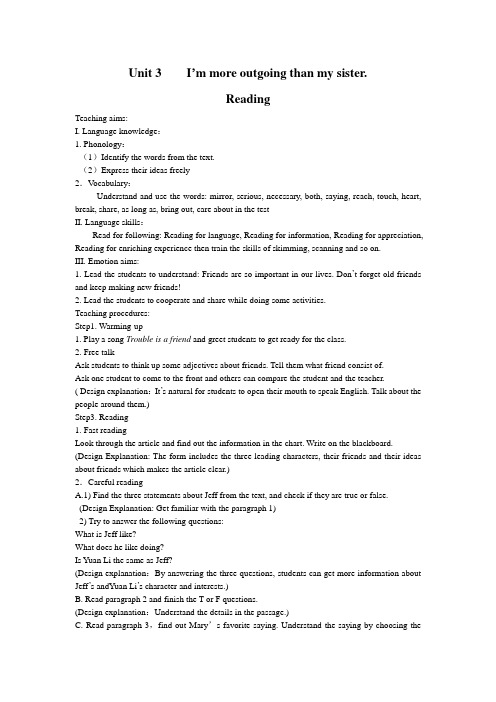
Unit 3 I’m more outgoing than my sister.ReadingTeaching aims:I. Language knowledge:1. Phonology:(1)Identify the words from the text.(2)Express their ideas freely2.V ocabulary:Understand and use the words: mirror, serious, necessary, both, saying, reach, touch, heart, break, share, as long as, bring out, care about in the testII. Language skills:Read for following: Reading for language, Reading for information, Reading for appreciation, Reading for enriching experience then train the skills of skimming, scanning and so on.III. Emotion aims:1. Lead the students to understand: Friends are so important in our lives. Don’t forget old friends and keep making new friends!2. Lead the students to cooperate and share while doing some activities.Teaching procedures:Step1. Warming-up1. Play a song Trouble is a friend and greet students to get ready for the class.2. Free talkAsk students to think up some adjectives about friends. Tell them what friend consist of.Ask one student to come to the front and others can compare the student and the teacher.( Design explanation:It’s natural for students to open their mouth to speak English. Talk about the people around them.)Step3. Reading1. Fast readingLook through the article and find out the information in the chart. Write on the blackboard. (Design Explanation: The form includes the three leading characters, their friends and their ideas about friends which makes the article clear.)2.Careful readingA.1) Find the three statements about Jeff from the text, and check if they are true or false. (Design Explanation: Get familiar with the paragraph 1)2) Try to answer the following questions:What is Jeff like?What does he like doing?Is Yuan Li the same as Jeff?(Design explanation:By answering the three questions, students can get more information about Jeff’s andYuan Li’s character and interests.)B. Read paragraph 2 and finish the T or F questions.(Design explanation:Understand the details in the passage.)C. Read paragraph 3,find out Mary’s favorite saying. Understand the saying by choosing thesimilar sentences.(Design explanation: The saying is the most difficult sentence, understand it through a different way.)Step4. DiscussionWhich of these students do you want to make friends with? Why?Tips: What are you like?Do you think friends should be the same or different?What's your idea about making friends?Who do you want to make friends with?What is he/she like?(Design explanation: To check the students’understanding of the passage, and lead them to express their ideas freely)Step5. DebateShould friends be the same or different, or you don’t care? Please show your ideas and give some reasons to support your idea.(Design explanation: After learning the class, students can change the input into output.)Step6. Let’s rememberFriends are so important in our lives. Don’t forget old friends and keep making new friends! (Design explanation: Cherish the friendship around us.)Step7.HomeworkWrite down your idea abou t making friends by comparing you and your friend, you’d better write down a story between you and your friend.(Design explanation: Students can revise the knowledge they’ve learned today.Blackboard design:Unit 3 I’m more outgoing than my sister.ReadingNames Their friends Ideas about friendsJeff Green Larry doesn’t care reach for your hand Huang Lei Carol should be the same touch your heart Mary Smith Yuan Li not necessary to be the sameTeaching reflection:Time is limit, and chances are limited for students to speak English and express their ideas in class, we teachers need to create more chances. Thank you!。
英语人教版五年级下册Unit 3 complete teaching plan
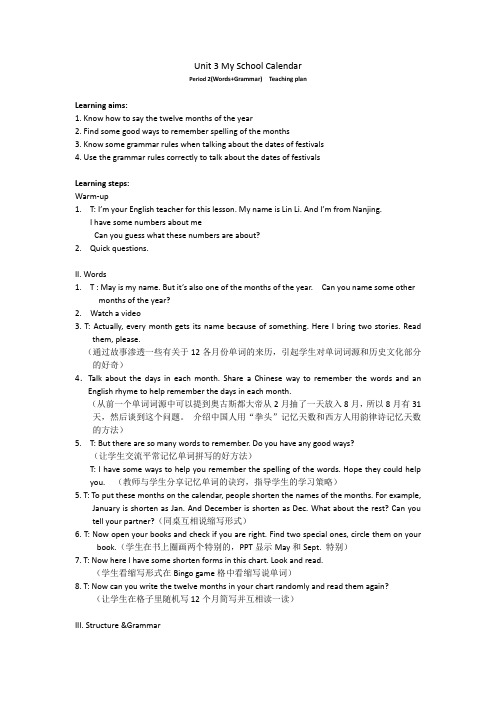
Unit 3 My School CalendarPeriod 2(Words+Grammar) Teaching planLearning aims:1. Know how to say the twelve months of the year2. Find some good ways to remember spelling of the months3. Know some grammar rules when talking about the dates of festivals4. Use the grammar rules correctly to talk about the dates of festivalsLearning steps:Warm-up1.T: I’m your English teacher for this lesson. My name is Lin Li. And I’m from Nanjing.I have some numbers about meCan you guess what these numbers are about?2.Quick questions.II. Words1.T : May is my name. But it’s also one of the months of the year. Can you name some othermonths of the year?2. Watch a video3. T: Actually, every month gets its name because of something. Here I bring two stories. Readthem, please.(通过故事渗透一些有关于12各月份单词的来历,引起学生对单词词源和历史文化部分的好奇)4.Talk about the days in each month. Share a Chinese way to remember the words and an English rhyme to help remember the days in each month.(从前一个单词词源中可以提到奥古斯都大帝从2月抽了一天放入8月,所以8月有31天,然后谈到这个问题。
Teaching Plan 9A Unit 3 Grammar(Adverbs)
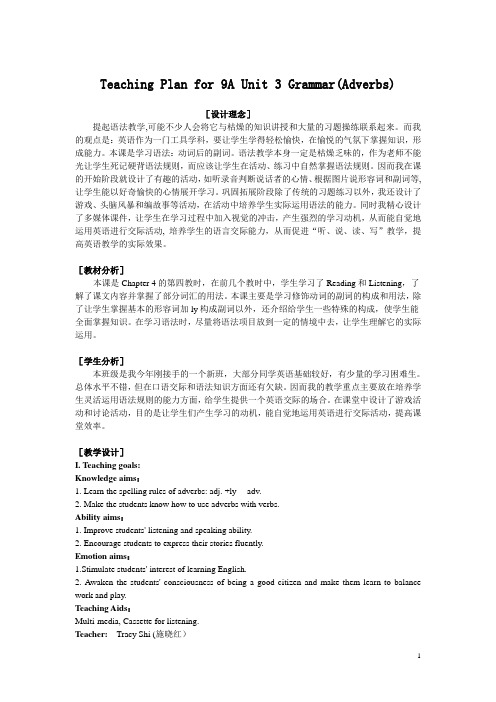
Teaching Plan for 9A Unit 3 Grammar(Adverbs)[设计理念]提起语法教学,可能不少人会将它与枯燥的知识讲授和大量的习题操练联系起来。
而我的观点是:英语作为一门工具学科,要让学生学得轻松愉快,在愉悦的气氛下掌握知识,形成能力。
本课是学习语法:动词后的副词。
语法教学本身一定是枯燥乏味的,作为老师不能光让学生死记硬背语法规则,而应该让学生在活动、练习中自然掌握语法规则。
因而我在课的开始阶段就设计了有趣的活动,如听录音判断说话者的心情、根据图片说形容词和副词等,让学生能以好奇愉快的心情展开学习。
巩固拓展阶段除了传统的习题练习以外,我还设计了游戏、头脑风暴和编故事等活动,在活动中培养学生实际运用语法的能力。
同时我精心设计了多媒体课件,让学生在学习过程中加入视觉的冲击,产生强烈的学习动机,从而能自觉地运用英语进行交际活动, 培养学生的语言交际能力,从而促进“听、说、读、写”教学,提高英语教学的实际效果。
[教材分析]本课是Chapter 4的第四教时,在前几个教时中,学生学习了Reading和Listening,了解了课文内容并掌握了部分词汇的用法。
本课主要是学习修饰动词的副词的构成和用法,除了让学生掌握基本的形容词加ly构成副词以外,还介绍给学生一些特殊的构成,使学生能全面掌握知识。
在学习语法时,尽量将语法项目放到一定的情境中去,让学生理解它的实际运用。
[学生分析]本班级是我今年刚接手的一个新班,大部分同学英语基础较好,有少量的学习困难生。
总体水平不错,但在口语交际和语法知识方面还有欠缺。
因而我的教学重点主要放在培养学生灵活运用语法规则的能力方面,给学生提供一个英语交际的场合。
在课堂中设计了游戏活动和讨论活动,目的是让学生们产生学习的动机,能自觉地运用英语进行交际活动,提高课堂效率。
[教学设计]I. Teaching goals:Knowledge aims:1. Learn the spelling rules of adverbs: adj. +ly ---adv.2. Make the students know how to use adverbs with verbs.Ability aims:1. Improve students' listening and speaking ability.2. Encourage students to express their stories fluently.Emotion aims:1.Stimulate students' interest of learning English.2. Awaken the students' consciousness of being a good citizen and make them learn to balance work and play.Teaching Aids:Multi-media, Cassette for listening.Teacher: Tracy Shi (施晓红)Teaching Procedure:Steps Contents Teacher’s activities Students’activitiesPurposesI. Pre-task Preparations 1.Warming-up.A song: Webelong to thesea.To encourage thestudents to sing thesong.To listen to thesong and singafter the song.To stimulate thestudents' interest inlearning English.2. Listening. Ask: In which waydoes the man speak?To match thepresentationwith the correctadverb.To evoke students’prior knowledgeand call theirattention to the newmaterials.II.While-task procedures 1. Learn someadjectives andadverbs.1)To show studentssome pictures withdifferent facialexpressions.2) Ask: How doeshe/she feel?How is he/shewatching TV?To say someadjectives andadverbsaccording tothe picturesgiven.To arouse students'interest on adverbsand make themknow the differencebetween adjectivesand adverbs2.Teach theusages ofadverbsTo teach the studentsthe spelling rules ofadverbs and somespecial usages ofadverbs by showingthem some examplesTo learn thespelling rulesof adverbs andsome specialusages ofadverbsTo help the studentslearn the usages ofadverbs.3. Checkout 1) To ask the studentsto say the adverbform of eachadjective one by one.2) ToAsk some questionsabout Happy Day.1) Say theadverb form ofeach adjective.2) To answerthe questionswith a verb andan adverb.To make studentslearn more detailsabout the text.To practise thegrammar in anauthentic situation.III. Post-task activities 1. An adverbgame.1)Prepare four sets ofadverbs. Ask eachgroup to think of aname of their groupand then have agroup competition.2)Tell the students tomime the actions ordescribe the words tomake the student inthe front guess theadverbs.E.g. I run likethis...1)Think of agroup name byusing one kindof fish.Elect onestudent to comeout to the frontto guess theadverbs.2)The groupmembers canuse theirgestures as wellas words tomake thestudents guessthe adverbs1) To make thestudents get moreinterested in thelessons.2) To revise theknowledge throughgames.To provide moreopportunities for thestudents to shareopinions withothers.2.Brainstorming.To provide thestudents twosituations:1)How did he drive?He drove_______.2)In the schoolcanteen, we ate lunch__________.Ask the students tothink of as manyadverbs as they can.Students thinkof as manyadverbs as theycan.Hedrove________.In the schoolcanteen, we atelunch________.To improvestudents’ abilities ofcooperativelearning.To make thestudents learn thatwe should drivecarefully becausesafety is first andeverybody shouldbehave well.3. Make up a story with the given adverbs. To instruct thestudents to make up astory in small groups.To make up astory in groupsand then ask arepresentativeto tell the classtheir story.To put the grammarthey've learnt todayinto practice. Toreinforce theknowledge andcultivate students'all-round qualities.IV. Assignments 1.Write a story about the topic:"A story of Garfield" by using suitableadverbs.plementary exercises: Multiple Choices3.Grammar Book(P17-20)教学说明:这课是本单元的第四教时,前几个课时学习了Reading和Listening两个部分,课文主要讲了Happy和African Ghost Fish的故事。
高中英语:Unit3 English manners教案(上海新世纪版S1A)
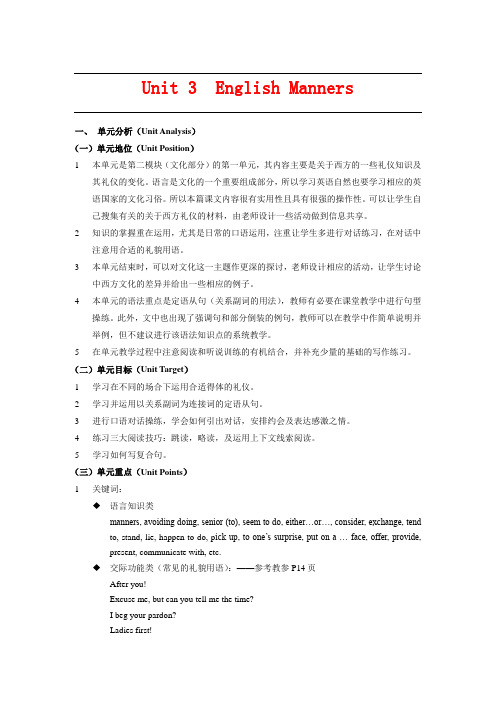
Unit 3 English Manners一、单元分析(Unit Analysis)(一)单元地位(Unit Position)1 本单元是第二模块(文化部分)的第一单元,其内容主要是关于西方的一些礼仪知识及其礼仪的变化。
语言是文化的一个重要组成部分,所以学习英语自然也要学习相应的英语国家的文化习俗。
所以本篇课文内容很有实用性且具有很强的操作性。
可以让学生自己搜集有关的关于西方礼仪的材料,由老师设计一些活动做到信息共享。
2 知识的掌握重在运用,尤其是日常的口语运用,注重让学生多进行对话练习,在对话中注意用合适的礼貌用语。
3 本单元结束时,可以对文化这一主题作更深的探讨,老师设计相应的活动,让学生讨论中西方文化的差异并给出一些相应的例子。
4 本单元的语法重点是定语从句(关系副词的用法),教师有必要在课堂教学中进行句型操练。
此外,文中也出现了强调句和部分倒装的例句,教师可以在教学中作简单说明并举例,但不建议进行该语法知识点的系统教学。
5 在单元教学过程中注意阅读和听说训练的有机结合,并补充少量的基础的写作练习。
(二)单元目标(Unit Target)1 学习在不同的场合下运用合适得体的礼仪。
2 学习并运用以关系副词为连接词的定语从句。
3 进行口语对话操练,学会如何引出对话,安排约会及表达感激之情。
4 练习三大阅读技巧:跳读,略读,及运用上下文线索阅读。
5 学习如何写复合句。
(三)单元重点(Unit Points)1 关键词:◆语言知识类manners, avoiding doing, senior (to), seem to do, either…or…, consider, exchange, tendto, stand, lie, happen to do, p ick up, to one’s surprise, put on a … face, offer, provide,present, communicate with, etc.◆交际功能类(常见的礼貌用语):——参考教参P14页After you!Excuse me, but can you tell me the time?I beg your pardon?Ladies first!I’d like to meet Dr Snow.This is Jane.I ’m very glad to meet you!It’s a pleasure to meet you!Nice to meet you!2 功能:1)Starting a conversion ——参考课文P44页Useful language●Excuse me, do you mind if I sit here?●Excuse me, could you tell me the time?●Er, could you help me, I’m trying to find my way to…●Excuse me, aren’t you John Smith?●Sorry to trouble you, but do you happen to know when the lecture begins?●Say, haven’t I seen you somewhere before?2)Making an appointment ——参考课文P45页Useful languageA: 1 Will you be free this coming Friday?2 Are you doing anything special tonight/3 Let’s make a date to see a film.4 I’d like to make an appointment for next Monday.5 Shall I come round for you at about 10 o’clock?6 Will 9 o’clock be all right?7 Would you prefer some other time?B: 1 That’d be lovely.2 How nice of you! Thanks a lot.3 Mmm, that’s a great idea.4 I’ll be most delighted to meet you at 10:00 Monday morning.5 Oh, dear, I’m afraid I’m busy tonight.6 Tonight’s difficult. How about tomorrow evening?7 I’m sorry, I’m expecting some visitors this evening.8 This evening’s a bit of a problem. What about tomorrow?3)Express gratitudeA: 1 Many thanks.2Thanks a lot!3Thank you very much!4It’s so kind of to help me carry the luggage.5I would appreciate it very much if you can take a message for me.B: 1 You’re welcome.2Don’t mention it!3It’s a pleasure.3 语法点:1 定语从句(关系副词,when, where, why)关系副词引导的定语从句充当主句的状语,when指时间,where指地点,why指原因。
Unit 3 Manners
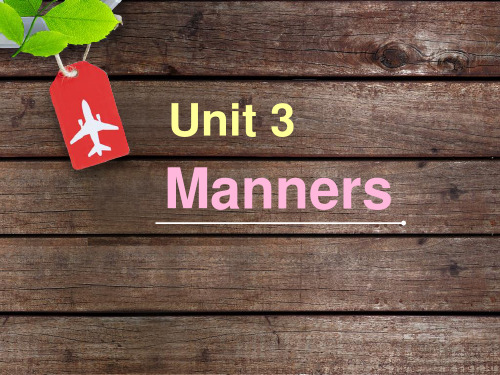
pleasure n. [ U ] pleasure n. [ C ]
e.g.
乐趣
有乐趣wed on no sign of pleasure at seeing her. 见到她的时候,他没有显示出高兴的样子。 It’s a pleasure to work with you. 同你一起工作是一种乐趣。
One day the idea of giving up smoking came into my head. 有一天他想到了要戒烟。
tip: useful information get started: start
force sth. sb. 把...强加于人
We forced the money on him because we knew he needed it. 我们一定要把钱给他,因为我们知道他需 要钱。
Expression Match
C E
H
D
O N
M
I
F
A
L J G B K
How to chat with Chinese people?
How to chat with foreign people?
In Foreign Countries
• Speaking with your mouth full of food • Eating and drinking something while walking down the street
• Talking loudly in pubic
• Staring at someone in public • When yawning or coughing, always covering your mouth with your hand
Unit3Manners(teachingplan)
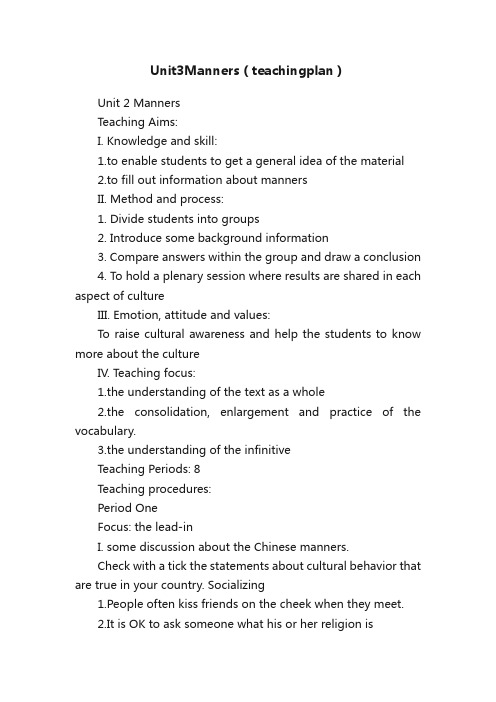
Unit3Manners(teachingplan)Unit 2 MannersTeaching Aims:I. Knowledge and skill:1.to enable students to get a general idea of the material2.to fill out information about mannersII. Method and process:1. Divide students into groups2. Introduce some background information3. Compare answers within the group and draw a conclusion4. To hold a plenary session where results are shared in each aspect of cultureIII. Emotion, attitude and values:To raise cultural awareness and help the students to know more about the cultureIV. Teaching focus:1.the understanding of the text as a whole2.the consolidation, enlargement and practice of the vocabulary.3.the understanding of the infinitiveTeaching Periods: 8Teaching procedures:Period OneFocus: the lead-inI. some discussion about the Chinese manners.Check with a tick the statements about cultural behavior that are true in your country. Socializing1.People often kiss friends on the cheek when they meet.2.It is OK to ask someone what his or her religion is3.It is all right to ask someone what his or her religion is4.It is common to introduce yourself to new neighbors and give them a small gift.5.People always arrive on time when they are invited to someone’s house.6.It’s ok to ask for a second helping when eating at a friend’s house.7.It’s ok to bring a friend or family member when you’re invited to a party at someone’shome.8.It’s ok to drop by a friend’s house without calling first.9.When friends have dinner out together, each person pays his or her share of the check. Out in public10.It’s ok to blow your nose in public11.it’s all right to chew gum while talking to someone.12.It’s common to bargain when you buy something in stores.13.If you want to smoke around other people, you should always ask if it is ok.At work or school14.In an office, people usually prefer to be called by their first name.15.In high school it’s common to call a teacher by his or her first name.16.Students always stand up when the teacher enters the classroom.Dating and marriage17.Parents often decide who their children will marry.18.Teenagers go out on dates a lot.19.A man usually gives a woman a gift when they go out ona date.20.Young people usually live with their parents after they get married.II. picture talk1. some questions about the picture.2.make up a story according to the pictureIII. Some common manners in the WestIt is a great help for the person who is learning a foreign language to know some customs and manners for the people who speaks it, because the language is very closely associated with them. I will tell you some common western manners.Meeting and greeting people1.GreetingThe simplest thing to say is “good morning”“good afternoon” or “good evening”. This greeting is given to one whom you know only slightly, or to any one you are passing quickly. “how are you” is usually used when you are not in such a hurry. No answer is expected other than “fine, thank you”. “hello” is the commonest form of greeting between good friends.2.When a man raises his hatIf you are wearing a hat which can be taken bold of easily, it is customary to raise it slightly off your head when you greet a girl or a woman.3.When to shake handsIt is customary to shake hands when you first meet someone. And usually friends shake hands when they meet after not having seen each other for some time. However it is not necessary to shake hands./doc/0425519.html,e the person’s nameIt is always good form to use the name of the person you are greeting. You might say “good morning, Mr. Moncrieff” or “hello, Franklin”. A person’s surname should be used unless he is good friend or school-mate..IntroductionIn schoolIn public placesAssignment1.review the new words2.read the textPeople TwoTeaching Aims:1.to learn the vocabulary in the text briefly.2.to have a general idea of the text.Teaching procedures:I. read the new wordsII. Some explanations to the new wordsIII. Prepare to readExercise AIV. Skim the text and get the main idea of the text.Assignment1.Recite the new words2.find out the phrases of the textPeriod Three-FourFocus: explain the sentences structure and languages of the textLanguage points:1.perfect adj. (excellence)最恰当的;理想的(此词没比较级和最高级)e. g. Practice makes perfect. 熟能生巧He speaks perfect French. 他说一口流利的法语.perfection n. 完美,尽善尽美2. utter v. 说出,发出(声音)utter a cry 发出叫声e.g. He looked at me without uttering a word. 他看着我,没说一句话。
Good manners教案
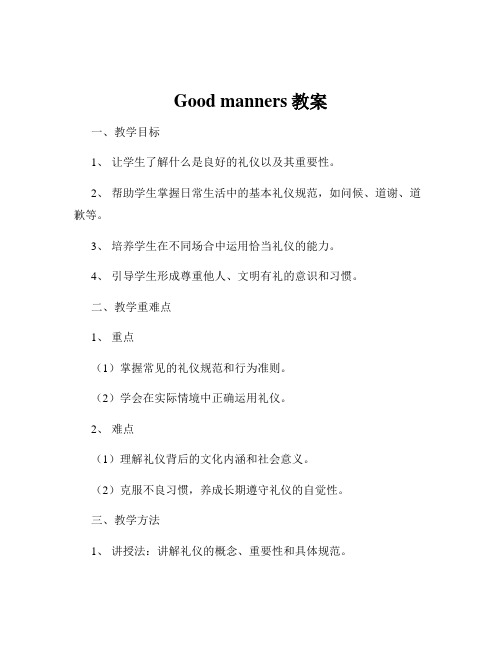
Good manners教案一、教学目标1、让学生了解什么是良好的礼仪以及其重要性。
2、帮助学生掌握日常生活中的基本礼仪规范,如问候、道谢、道歉等。
3、培养学生在不同场合中运用恰当礼仪的能力。
4、引导学生形成尊重他人、文明有礼的意识和习惯。
二、教学重难点1、重点(1)掌握常见的礼仪规范和行为准则。
(2)学会在实际情境中正确运用礼仪。
2、难点(1)理解礼仪背后的文化内涵和社会意义。
(2)克服不良习惯,养成长期遵守礼仪的自觉性。
三、教学方法1、讲授法:讲解礼仪的概念、重要性和具体规范。
2、演示法:通过教师示范、视频展示等方式,让学生直观感受正确的礼仪行为。
3、讨论法:组织学生讨论生活中的礼仪现象,加深对礼仪的理解。
4、角色扮演法:让学生模拟不同场景,实践礼仪的运用。
四、教学过程1、导入(5 分钟)通过播放一段展示文明与不文明行为对比的视频,引导学生思考礼仪的重要性,从而引出本节课的主题——Good manners。
2、知识讲解(15 分钟)(1)解释什么是良好的礼仪,包括对他人的尊重、关心和友善。
(2)列举日常生活中的常见礼仪,如见面问候、礼貌用语(请、谢谢、对不起等)、餐桌礼仪、公共场合的行为规范等。
3、案例分析(10 分钟)展示一些具体的案例,让学生分析其中的人物行为是否符合礼仪规范,并说明原因。
例如,在公交车上大声喧哗、插队等不文明行为,以及主动让座、有序排队等文明行为。
4、小组讨论(10 分钟)将学生分成小组,讨论以下问题:(1)为什么要遵守礼仪?(2)不遵守礼仪可能会带来哪些后果?(3)在学校、家庭和社会中,我们应该如何展现良好的礼仪?5、角色扮演(15 分钟)设置不同的场景,如学校、餐厅、商店等,让学生分组进行角色扮演,展示在这些场景中正确的礼仪行为。
其他小组进行观察和评价。
6、总结归纳(5 分钟)回顾本节课所学的主要内容,强调良好礼仪对个人和社会的重要性,鼓励学生在日常生活中积极践行良好的礼仪。
上海市上海理工大学附属中学高一英语上册《Unit3 Manners》教案
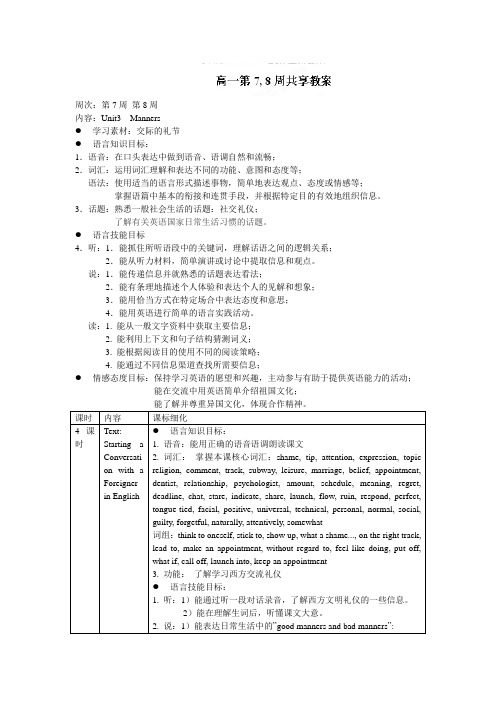
周次:第7周第8周
内容:Unit3 Manners
●学习素材:交际的礼节
●语言知识目标:
1.语音:在口头表达中做到语音、语调自然和流畅;
2.词汇:运用词汇理解和表达不同的功能、意图和态度等;
语法:使用适当的语言形式描述事物,简单地表达观点、态度或情感等;
掌握语篇中基本的衔接和连贯手段,并根据特定目的有效地组织信息。
3.话题:熟悉一般社会生活的话题:社交礼仪;
了解有关英语国家日常生活习惯的话题。
●语言技能目标
4.听:1.能抓住所听语段中的关键词,理解话语之间的逻辑关系;
2.能从听力材料,简单演讲或讨论中提取信息和观点。
说:1.能传递信息并就熟悉的话题表达看法;
2.能有条理地描述个人体验和表达个人的见解和想象;
3.能用恰当方式在特定场合中表达态度和意思;
4.能用英语进行简单的语言实践活动。
读:1. 能从一般文字资料中获取主要信息;
2. 能利用上下文和句子结构猜测词义;
3. 能根据阅读目的使用不同的阅读策略;
4. 能通过不同信息渠道查找所需要信息;
●情感态度目标:保持学习英语的愿望和兴趣,主动参与有助于提供英语能力的活动;
能在交流中用英语简单介绍祖国文化;
朱小玮。
《学前教育英语综合教程(上册)》课件 Unit 3 Manners

Discussion
1. Have you got any ideas of good manners in our culture? 2. “Manners make the man”, do you agree? Why or why not?
the balance of money returned when an amount given is more than what is due零钱,找头 special, distinctive, or unique明确的,特别的 a statement of fact or opinion, especially a remark that expresses a personal reaction or attitude评论,评语
02
Reading
Text A
Pre-reading Questions 1. When do you say “please” in your every day life? Will that help you
to get what you want more easily? 2. Have you ever say “thank you” to your parents? Give an example.
《学前教育英语综合教程》
(上册)
Unit 3 Manners
目 录
01
Listening & Speaking
英语人教版五年级下册Unit 3 complete teaching plan

Unit 3 My School CalendarPeriod 2(Words+Grammar) Teaching planLearning aims:1. Know how to say the twelve months of the year2. Find some good ways to remember spelling of the months3. Know some grammar rules when talking about the dates of festivals4. Use the grammar rules correctly to talk about the dates of festivalsLearning steps:Warm-up1.T: I’m your English teacher for this lesson. My name is Lin Li. And I’m from Nanjing.I have some numbers about meCan you guess what these numbers are about?2.Quick questions.II. Words1.T : May is my name. But it’s also one of the months of the year. Can you name some othermonths of the year?2. Watch a video3. T: Actually, every month gets its name because of something. Here I bring two stories. Readthem, please.(通过故事渗透一些有关于12各月份单词的来历,引起学生对单词词源和历史文化部分的好奇)4.Talk about the days in each month. Share a Chinese way to remember the words and an English rhyme to help remember the days in each month.(从前一个单词词源中可以提到奥古斯都大帝从2月抽了一天放入8月,所以8月有31天,然后谈到这个问题。
高一英语manners教案

Unit3 manners-grammar学案The Relative Clause一. 快捷识记·非限制性定于从句1. 1. 限制性定语从句不能省略, 如果省略了句子就不完整,而限制性定语从句可以省略,因为它仅仅是对先行词的附加说明Take the street that goes to the right.The library,(which is newly built,)will soon be open to the public.2. 限制性定语从句中,主句与从句之间没有逗号,非限制性定语从句中主句与从句之间必须用逗号隔开.3. 限制性定语从句中作宾语的关系代词可以省略, 而在非限制性定语从句中则不能省.4 非限制性定语从句不能用关系代词that.5.限制性定语从句的先行词只能是一个名词或代词,而非限制性定语从句的先行词可以是一个词, 也可以是一句话He didn’t pass the examination, which disappointed his parents.6. 非限制性定语从句所修饰的某人的亲属或某个东西,某个地方表示”唯一的,独一无二的”, 限制性定语从句表示这个亲属和地方不止一个.My brother who lives in New York has six children.我住在纽约的那个兄弟有六个孩子. (不止一个兄弟)My brother, who lives in New York, has six children.我有一个兄弟, 他住在纽约, 有六个孩子. (只有一个兄弟)Shanghai, which lies in the east of China, is a highly industrialized city.(因为上海只有一个, 必须在关系代词前用上逗号.)特殊的定语从句I.I. 嵌入式定语从句She is a top student, who they say has won five prizes in the contest.她是个优等生, 大家说她已经在比赛中获了五次奖“who has won five prizes in the contest” 既是student的定语从句, 又是they say的宾语, 而they say 类似插入语, 如果去掉并不影响句子的完整, 类似的还有:I have an idea which I’m sure will interest you.We will have a new teacher, who I know has just returned from Britain.He read a poem which we thought was written by a poet in the Qin Dinesty.II.II. that的特殊用法Can you tell me the way (that)/ in which you solved the difficult problem?This is the last time (that)I’ll give you a lesson.III.在非限制性定语从句中,of which / of whom 常用于基数词some,most,all,none,neither,either 等词后,而不用whose。
- 1、下载文档前请自行甄别文档内容的完整性,平台不提供额外的编辑、内容补充、找答案等附加服务。
- 2、"仅部分预览"的文档,不可在线预览部分如存在完整性等问题,可反馈申请退款(可完整预览的文档不适用该条件!)。
- 3、如文档侵犯您的权益,请联系客服反馈,我们会尽快为您处理(人工客服工作时间:9:00-18:30)。
Unit 2 MannersTeaching Aims:I. Knowledge and skill:1.to enable students to get a general idea of the material2.to fill out information about mannersII. Method and process:1. Divide students into groups2. Introduce some background information3. Compare answers within the group and draw a conclusion4. To hold a plenary session where results are shared in each aspect of cultureIII. Emotion, attitude and values:To raise cultural awareness and help the students to know more about the cultureIV. Teaching focus:1.the understanding of the text as a whole2.the consolidation, enlargement and practice of the vocabulary.3.the understanding of the infinitiveTeaching Periods: 8Teaching procedures:Period OneFocus: the lead-inI. some discussion about the Chinese manners.Check with a tick the statements about cultural behavior that are true in your country. Socializing1.People often kiss friends on the cheek when they meet.2.It is OK to ask someone what his or her religion is3.It is all right to ask someone what his or her religion is4.It is common to introduce yourself to new neighbors and give them a small gift.5.People always arrive on time when they are invited to someone’s house.6.It’s ok to ask for a second helping when eating at a friend’s house.7.It’s ok to bring a friend or family member when you’re invited to a party at someone’shome.8.It’s ok to drop by a friend’s house without calling first.9.When friends have dinner out together, each person pays his or her share of the check. Out in public10.It’s ok to blow your nose in public11.it’s all right to chew gum while talking to someone.12.It’s common to bargain when you buy something in stores.13.If you want to smoke around other people, you should always ask if it is ok.At work or school14.In an office, people usually prefer to be called by their first name.15.In high school it’s common to call a teacher by his or her first name.16.Students always stand up when the teacher enters the classroom.Dating and marriage17.Parents often decide who their children will marry.18.Teenagers go out on dates a lot.19.A man usually gives a woman a gift when they go out on a date.20.Young people usually live with their parents after they get married.II. picture talk1. some questions about the picture.2.make up a story according to the pictureIII. Some common manners in the WestIt is a great help for the person who is learning a foreign language to know some customs and manners for the people who speaks it, because the language is very closely associated with them. I will tell you some common western manners.• Meeting and greeting people1.GreetingThe simplest thing to say is “good morning”“good afternoon” or “good evening”. This greeting is given to one whom you know only slightly, or to any one you are passing quickly. “how are you” is usually used when you are not in such a hurry. No answer is expected other than “fine, thank you”. “hello” is the commonest form of greeting between good friends.2.When a man raises his hatIf you are wearing a hat which can be taken bold of easily, it is customary to raise it slightly off your head when you greet a girl or a woman.3.When to shake handsIt is customary to shake hands when you first meet someone. And usually friends shake hands when they meet after not having seen each other for some time. However it is not necessary to shake hands.e the person’s nameIt is always good form to use the name of the person you are greeting. You might say “good morning, Mr. Moncrieff” or “hello, Franklin”. A person’s surname should be used unless he is good friend or school-mate..• Introduction• In school• In public placesAssignment1.review the new words2.read the textPeople TwoTeaching Aims:1.to learn the vocabulary in the text briefly.2.to have a general idea of the text.Teaching procedures:I. read the new wordsII. Some explanations to the new wordsIII. Prepare to readExercise AIV. Skim the text and get the main idea of the text.Assignment1.Recite the new words2.find out the phrases of the textPeriod Three-FourFocus: explain the sentences structure and languages of the textLanguage points:1.perfect adj. (excellence)最恰当的;理想的(此词没比较级和最高级)e. g. Practice makes perfect. 熟能生巧He speaks perfect French. 他说一口流利的法语.⇒ perfection n. 完美,尽善尽美2. utter v. 说出,发出(声音)utter a cry 发出叫声e.g. He looked at me without uttering a word. 他看着我,没说一句话。
3.tongue-tied adj.on the tip of one’s tongue 话就在嘴边4.shame n.耻辱,羞耻(u.c.n); 可耻的事,遗憾的事(c.n.)v. 使。
